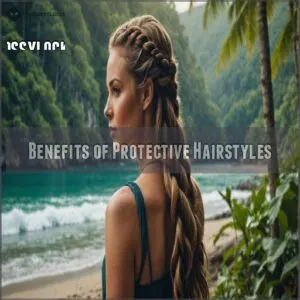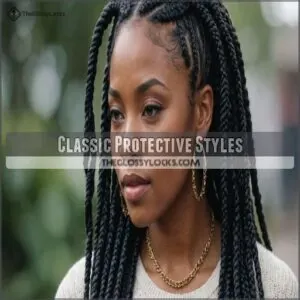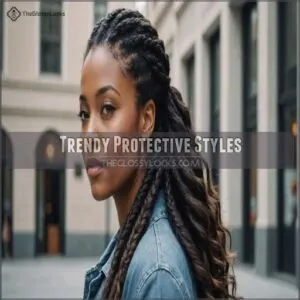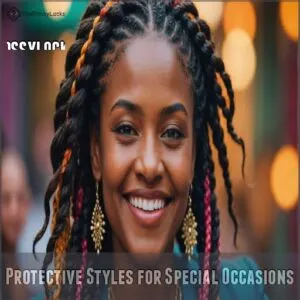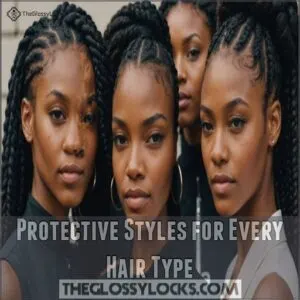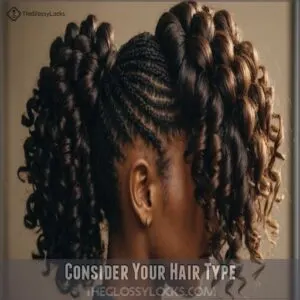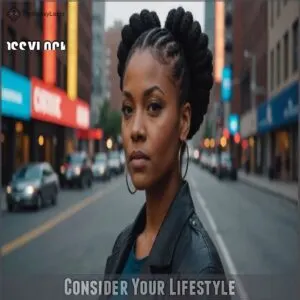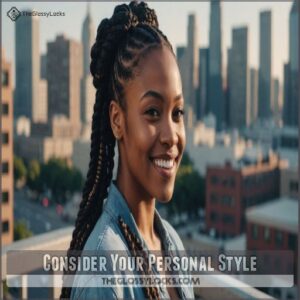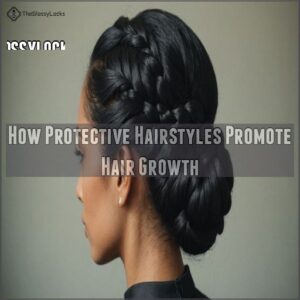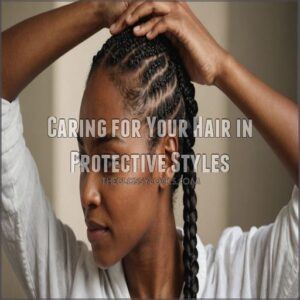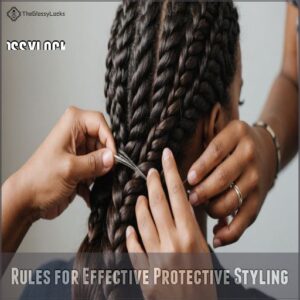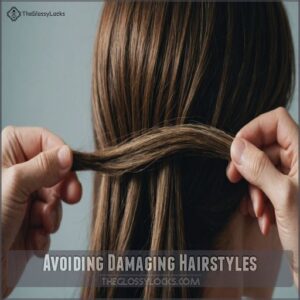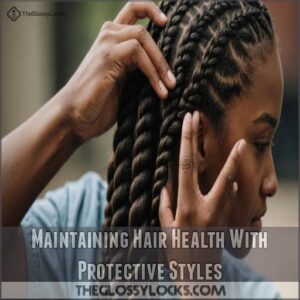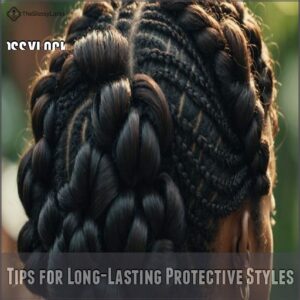This site is supported by our readers. We may earn a commission, at no cost to you, if you purchase through links.
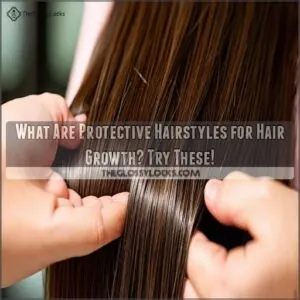 You’ll love how protective hairstyles can transform your hair growth journey.
You’ll love how protective hairstyles can transform your hair growth journey.
These styles shield your strands from daily wear and tear by keeping them tucked away and protected.
Box braids, cornrows, twists, and updos aren’t just trendy – they’re your hair’s best friends.
They minimize breakage, lock in moisture, and give your fragile ends a much-needed break from constant manipulation.
Think of protective styles as a cozy winter coat for your hair: they guard against damage while letting your natural growth flourish underneath.
The secret lies in choosing the right style and maintaining it properly.
Table Of Contents
- Key Takeaways
- Benefits of Protective Hairstyles
- Types of Protective Hairstyles
- Choosing The Right Protective Hairstyle
- How Protective Hairstyles Promote Hair Growth
- Caring for Your Hair in Protective Styles
- Rules for Effective Protective Styling
- Avoiding Damaging Hairstyles
- Maintaining Hair Health With Protective Styles
- Tips for Long-Lasting Protective Styles
- Frequently Asked Questions (FAQs)
- What are protective styles for natural hair?
- What works best for hair growth quickly?
- What is the most protective hairstyle?
- Does wearing a protective hairstyle improve hair growth?
- Do protective hairstyles work?
- What are the best protective hairstyles for curly hair?
- What protective style is best for hair growth?
- Which hairstyle is best for hair growth?
- Which braids are best for hair growth?
- What is the least damaging protective hair style?
- How often should you wash hair in protective styles?
- Can protective styles damage your hairline over time?
- What products work best for protective style maintenance?
- Are protective styles suitable for thinning or fine hair?
- When should you take breaks between protective styles?
- Conclusion
Key Takeaways
- Protective hairstyles like box braids, cornrows, and twists shield your hair from daily damage by minimizing manipulation and reducing breakage.
- You’ll need to keep your protective style for 4-6 weeks max, maintain proper moisture levels, and use a silk/satin scarf at night to preserve the style.
- You shouldn’t wear styles too tight or wet, as this can cause traction alopecia and breakage—opt for gentle installation and regular scalp care instead.
- You’re better off switching up your protective styles regularly and giving your hair breaks between installations to prevent buildup and maintain scalp health.
Benefits of Protective Hairstyles
When you embrace protective hairstyles, you’re giving your hair a chance to minimize breakage and grow healthier by reducing constant styling and friction.
Imagine your hair as a tiny superhero protected by these styles, keeping it moisturized and frizz-free along the way!
Minimizing Hair Breakage
For managing hair breakage, don’t underestimate the power of protective hairstyles!
By reducing daily brushing and styling, you give your hair’s elasticity a chance to shine.
Think of braids as a popular protective hairstyle for hair growth, which can help retain length by minimizing breakage and reducing manipulation, as seen in braids and hair growth. Think of low manipulation styles like box braids or twists as your hair’s best friends.
They shield your strands from harsh styling tools and environmental stress, keeping them strong.
Promoting Hair Growth
Protective styles aren’t just about preventing breakage; they also give your hair a chance to grow longer and stronger.
Think of it as a vacation for your strands.
Less tugging and pulling means happier, healthier follicles.
A healthy scalp is key, so focus on good scalp health.
Proper diet and hair vitamins help too.
Stress management? Yep, that impacts hair growth cycles.
Low manipulation hairstyles like hair growth braids and twists are your best friends.
They’re all part of the plan to achieve those Rapunzel-length locks!
Retaining Moisture
Keeping your hair hydrated is like giving it a well-deserved drink.
Here’s your go-to list for moisture-packed locks:
- Deep conditioning: Regularly treat your hair with a rich hair mask.
- Water-based leave-ins: Lightweight hydration that your hair will love.
- Scalp hydration: Keeps your roots healthy.
- Moisturizing products: Choose ones that match your hair porosity for the best hydration.
Reducing Frizz
Humidity can turn your hair into a frizz monster, but protective styles have your back.
Shield your strands with options like braids and twists, which keep frizz at bay.
Pair this with frizz-free products, a silk scarf, or a satin pillowcase for extra protection.
Incorporating hair oils boosts hydration, giving you smooth, sleek hair ready for growth.
Types of Protective Hairstyles
You’ve got a world of options regarding protective hairstyles, and each offers its own flair and benefits.
From timeless classics like box braids and cornrows to trendy looks perfect for any occasion, your hair will thank you for the loving protection and style.
Classic Protective Styles
Think of classic protective styles as your hair’s best friend, offering low-maintenance beauty with timeless elegance.
Styles like box braids, cornrows, and twists aren’t just chic—they’re practical too.
Perfect for everyday wear, these hairstyles help lock in moisture and promote hair growth.
With some simple styling techniques, you can enjoy both versatility and hair health effortlessly.
Trendy Protective Styles
Who says protective styles can’t be fun and stylish?
Explore braided bobs for a sleek, modern twist, or Marley twists with bold colors for a playful look.
Try low puffs and stitched cornrows for a chic daily vibe, or elevate your hair with twisted high ponytails.
These styles are great for minimizing damage caused by environmental factors like sun exposure and chemicals, but also support hair growth by reducing breakage.
Protective Styles for Special Occasions
Got an event where you want to shine with killer hair?
Try protective styles that turn heads.
Bantu knots or floral box braids offer perfect wedding hairstyles.
For prom styles, braided faux hawks add a chic twist.
Party updos like goddess locs with curly ends give you that red carpet look.
These protective styles keep your hair healthy on your growth journey.
Protective Styles for Every Hair Type
Your hair’s unique texture deserves a protective style that’s just right.
For curly hair, consider braids or twists; both are low-manipulation options.
If you have straight hair, a sleek low bun is perfect.
Braids offer more structure than twists, but twists are often faster.
No matter your hair type, a natural hair care routine is key for growth.
Remember, protective styles aren’t one-size-fits-all—find what works best for you!
Choosing The Right Protective Hairstyle
Choosing the right protective hairstyle is like picking the perfect outfit—it needs to match your hair type, lifestyle, and personal flair.
Consider if you’ll be running marathons or attending virtual meetings, as the style should comfortably hug your routine while making your hair feel pampered and stylish.
Consider Your Hair Type
When choosing a protective hairstyle, think about your hair texture, porosity, thickness, and density.
Got curly, thick hair? Braids might lock in moisture perfectly.
Fine, low-porosity hair could pair best with loose twists to avoid tension.
Remember, what works for one scalp mightn’t suit another.
Braiding reduces friction and breakage by providing a strong structure for the hair, learn more about does braiding help hair growth. Tailor your style to nurture hair protection while promoting growth.
Consider Your Lifestyle
Living life on the go? Balance your protective hairstyle with your lifestyle.
Busy with time constraints or frequent travel plans? Opt for low-maintenance styles that endure your schedule.
If you’re into workouts or wash your hair often, for those with 4C hair types, consider understanding 4C hair care, if you’re into workouts or wash your hair often, consider options that suit your activity level and hair washing frequency.
Think of your sleep habits, ensuring styles last overnight too!
Consider Your Personal Style
Think of your hairstyle as an extension of your personality.
Want protective styles that fit your hair growth journey?
Here’s a hair growth tip: 1. Choose long hair protective styles that mirror your unique style inspiration. 2. Mix everyday looks with special occasion styles for versatility. 3. Let your hair goals guide your selections, and enjoy the playful journey!
How Protective Hairstyles Promote Hair Growth
Protective hairstyles work wonders by reducing how much you handle your hair and cutting down on friction, letting your hair grow longer and stronger.
Think of them as tiny guardians keeping your hair safe and sound, so you can say goodbye to pesky breakage and hello to lush, healthy locks.
Reducing Manipulation
Choosing the right protective hairstyle means understanding how it reduces manipulation.
By keeping your hands out of your hair, protective styles like box braids or low-tension twists let you focus on other things.
This break helps protect your strands from damage, boosting hair growth without constant effort.
Plus, who doesn’t love extra time to sleep in?
Minimizing Friction
Less manipulation means less friction, right?
Imagine your hair as a delicate silk scarf—constantly tugging and pulling it will fray the ends.
Protective styles like twists, braids, and locs keep things smooth.
Using a detangling brush and hair oils before styling helps, too.
Sleeping on satin pillowcases or wrapping your hair in a silk scarf minimizes nighttime friction.
These small changes can make a big difference in your hair’s health and growth journey. For instance, choosing the right headwear, such as loose-fitting beanies, can prevent hair loss and promote a healthy scalp!
Retaining Length
Length retention is your secret weapon against hair breakage.
Imagine your hair as a precious rope; the longer it stays intact, the more it grows!
To keep it strong, follow a regular trimming schedule, detangle properly, and maintain scalp care.
Remember, a healthy diet fuels your hair growth routine.
Protective hairstyles are the gatekeepers of retaining length.
Caring for Your Hair in Protective Styles
You’ve decided on a fabulous protective hairstyle, but now keeping it fresh and healthy is essential.
Regular moisturizing and scalp care, along with proper washing frequency, such as washing black hair every 7 to 14 days, will help your hair thrive, while avoiding buildup gives it room to breathe—because even the best styles deserve a little TLC!
Pre-Styling Prep
Ready to boost hair growth with protective hairstyles?
Start with a scalp massage to increase blood flow.
Detangle your hair gently to avoid breakage, and don’t skimp on moisturizing.
A deep conditioning session can work wonders.
Wrap it all up with protective products to seal in moisture.
These pre-styling steps lay the groundwork for healthier hair.
Styling Tips
Styling your hair for protective styles? It’s like setting the stage for a great show. Here’s how you nail it every time:
- Gentle Braiding: Use soft techniques to reduce stress, like knotless braids.
To further promote healthy hair growth, check out the best hair growth products available online.
- Hydrate: Keep your hair moisturized to enhance growth using a hair growth product from Hair Growth Products.
- Explore Twists: Opt for twists and locs for sleek, comfortable styles.
Aftercare Routine
After rocking your protective style, it’s time to show your hair some TLC.
Your aftercare routine is vital for maintaining healthy locks and promoting growth.
Here’s a quick guide to keep your tresses happy:
| Step | Action | Tip |
|---|---|---|
| 1 | Moisturize | Use a leave-in conditioner |
| 2 | Scalp care | Massage with light oil |
| 3 | Detangle | Gentle, section by section |
| 4 | Nighttime prep | Sleep on a satin pillowcase |
Remember, a little extra care goes a long way in keeping your protective style fresh and your hair thriving.
Rules for Effective Protective Styling
You’ve got your protective style locked in, but now it’s time to master the rules of the game.
Let’s explore how long to keep your style, prep your hair like a pro, and maintain that ‘do for maximum growth and minimum drama.
Duration of Style
Let’s talk about how long you should keep your protective style in.
It’s a balancing act.
You want to give your hair a break, but not for too long.
Aim for 4-6 weeks max.
Any longer and you’re risking hygiene issues and potential damage.
Remember, your scalp needs to breathe too!
If you start feeling itchy or see buildup, it’s time for a change.
Prepping Your Hair
Prepping your hair right sets the stage for successful protective styling.
Before you start, give your locks some TLC:
- Start with a thorough hair cleansing and scalp massage
- Deep condition to boost moisture and elasticity
- Detangle gently, working from ends to roots
To further enhance your hair’s health and growth, consider using a hair growth shampoo that can contribute to a healthy scalp environment.
Remember, oiling your hair can add extra nourishment.
Think of this prep as laying a strong foundation – it’ll help your protective style last longer and keep your hair healthier.
Maintaining Your Style
Keeping your protective style in tip-top shape is key to hair growth success.
Moisturize regularly to prevent dryness and breakage.
Using silk or satin pillowcases can also help reduce friction and prevent damage while you sleep.
At night, wrap your hair in a silk scarf or use a satin pillowcase to reduce friction.
Refresh your edges with a light oil or edge control product.
And remember, even protective styles need a break – give your hair some breathing room every few weeks.
Avoiding Damaging Hairstyles
You’re on the right track with protective styles, but watch out for these hair-damaging habits that can sabotage your growth goals.
Wearing the same tight ponytail daily, sporting overly tight braids, or putting up wet hair can all lead to breakage and slow down your progress.
Same Ponytail Every Day
Rocking that same ponytail daily? You might be doing your hair more harm than good.
While it’s tempting to stick with what’s easy, this habit can lead to hair breakage and even thinning around your hairline.
To combat this, consider incorporating regular trims every 4-12 weeks, as seen in various transition hairstyles for growing out short hair.
The constant tension in the same spot weakens your strands over time.
Mix it up! Try different styles or loosen that ponytail to give your locks a break and boost your scalp health.
Too-tight Braids
While tight braids might seem like a great way to keep your style in check, they’re actually a recipe for disaster.
Pulling your hair too tightly can lead to serious scalp health issues and even traction alopecia.
Don’t let the quest for a sleek look cost you your locks!
Instead, opt for looser braids that still look fab but give your scalp room to breathe.
Your hair will thank you!
Wet Updos
You might think wet updos are a quick fix, but they’re a recipe for disaster.
Wet hair is fragile, and twisting it up can lead to breakage and split ends.
Instead, let your locks air dry or use a gentle heat-drying method before styling.
If you’re in a rush, opt for a loose braid or low ponytail until your hair’s dry.
Your future self will thank you!
Maintaining Hair Health With Protective Styles
You’ll love how protective styles shield your hair from daily wear and tear, giving it a chance to flourish.
By tucking away those fragile ends and minimizing manipulation, you’re setting the stage for healthier, longer locks that’ll make your friends wonder if you’ve got a secret hair growth potion.
Minimizing Damage
Protective styles are your hair’s best friend for minimizing damage.
They shield your locks from everyday wear and tear, like friction from clothing or harsh weather.
By keeping your hair tucked away, you’re giving it a break from heat styling and chemical treatments, which can cause split ends if left unchecked, as seen in the effects of what happens if you dont cut split ends regularly.
This rest period allows your strands to recover and grow stronger.
Think of it as a spa day for your hair!
Boosting Hair Growth
Growing healthy hair isn’t just about what you put on it – it’s about giving your strands the right environment to thrive.
Once you’ve nailed down damage prevention, let’s focus on boosting that growth potential.
- Massage your scalp daily to increase blood flow
- Keep protective styles loose to avoid tension
- Switch up your style every 4-6 weeks
- Deep condition regularly while wearing protective styles
Tips for Long-Lasting Protective Styles
You’ll want to keep your protective style fresh and fabulous for weeks to come, and it’s easier than you might think.
With the right prep routine and daily maintenance tricks up your sleeve, you’ll master the art of making your braids, twists, or updos last longer while keeping your hair healthy and growing.
Prepping for Sleep
Getting ready for bed with a protective style isn’t rocket science – it’s all about the right prep.
Here’s what your nighttime routine should look like:
| Time | Action | Products |
|---|---|---|
| Evening | Remove jewelry | Satin scrunchies |
| Before bed | Moisturize edges | Light oil or cream |
| Bedtime | Cover hair | Satin bonnet/scarf |
Your hair’s like a delicate plant – give it the right environment to thrive while you sleep, and you’ll wake up to happy, healthy strands.
Styling for Longevity
After protecting your hair at night, let’s make your style last longer during the day.
Your styling technique can make or break how long your protective style holds up.
Knowing how to communicate effectively with your partner, like understanding that men respond to phrases like "I have your back", can also translate to better self-care and hair care habits.
Here’s what works:
- Apply a light holding spray before styling to keep flyaways in check
- Use bobby pins in an X-pattern for extra security
- Work with small sections for neater results
- Smooth edges with a silk scarf for 15 minutes post-styling
Aftercare for Long-Lasting Styles
To keep your protective styles fresh and fabulous, you’ll need a solid aftercare routine, similar to how men prioritize their grooming experience with products like soothing aftershave balm.
Your style’s longevity depends on how well you maintain it between styling sessions.
| Aftercare Must-Dos | Benefits |
|---|---|
| Nightly silk scarf wrap | Prevent frizz and friction |
| Weekly scalp oiling | Promotes healthy growth |
| Bi-weekly moisture spray | Maintains hair hydration |
| Monthly style refresh | Extends style lifespan |
To keep your protective styles fresh and fabulous, you’ll need a solid aftercare routine.
Your style’s longevity depends on how well you maintain it between styling sessions.
Frequently Asked Questions (FAQs)
What are protective styles for natural hair?
Your natural hair’s best friends include box braids, cornrows, twisted styles, and low-tension ponytails. These styles shield your hair from damage while letting it thrive and grow in peace.
What works best for hair growth quickly?
Regular scalp massages, protective styles, and a healthy diet rich in biotin boost hair growth.
You’ll also want to minimize heat styling, trim split ends regularly, and keep your strands moisturized with quality products.
What is the most protective hairstyle?
Like a shield for your precious strands, box braids reign supreme as the most protective hairstyle.
They’ll keep your ends tucked away safely while minimizing manipulation and maintaining moisture for weeks.
Does wearing a protective hairstyle improve hair growth?
Protective hairstyles can indeed boost hair growth.
They shield your locks from damage, minimize breakage, and retain moisture.
By giving your hair a break from daily styling, you’re creating an ideal environment for those strands to thrive and lengthen.
Do protective hairstyles work?
Imagine your hair thriving like a lush garden.
Yes, protective hairstyles work!
They shield your locks from damage, reduce breakage, and help retain moisture.
You’ll likely notice less shedding and more length retention over time.
What are the best protective hairstyles for curly hair?
Curly hair thrives with protective styles that keep moisture locked in.
Try twists, braids, or buns to shield your curls from damage.
Bantu knots, pineapple updos, and loose French braids are great options you’ll love.
What protective style is best for hair growth?
Your hair’s growth journey is unique, but low-manipulation styles like box braids, twists, and cornrows are top contenders.
They shield your strands from daily wear and tear, allowing your hair to thrive undisturbed.
Choose what feels comfortable for you.
Which hairstyle is best for hair growth?
Low-manipulation styles like box braids, twists, and cornrows are best for hair growth.
They protect your ends, reduce breakage, and minimize daily styling.
You’ll give your hair a break, allowing it to grow and thrive undisturbed.
Which braids are best for hair growth?
Picture your hair as a delicate garden.
Box braids and cornrows are like protective greenhouses, shielding your strands from damage.
They’ll keep your hair tucked away, minimizing breakage and encouraging growth.
Just remember to moisturize regularly!
What is the least damaging protective hair style?
The gentlest protective style for your locks is a loose, low bun.
It’s a breeze to create and won’t stress your strands.
You’ll give your hair a break while still looking put-together.
Win-win!
How often should you wash hair in protective styles?
Protective styles are like fortresses for your hair, but even fortresses need maintenance.
You should wash your hair in protective styles every 2-3 weeks.
This keeps your scalp clean and prevents product buildup without disturbing the style’s integrity.
Can protective styles damage your hairline over time?
Yes, protective styles can potentially damage your hairline if they’re too tight or worn for extended periods.
You’ll want to be mindful of tension, give your edges regular breaks, and moisturize to keep your hairline healthy.
What products work best for protective style maintenance?
Just as plants need the right soil, your protective styles crave proper nourishment.
You’ll want lightweight leave-in conditioners, moisturizing oils, and edge control products.
Don’t forget a satin scarf or bonnet to lock in moisture overnight!
Are protective styles suitable for thinning or fine hair?
You can rock protective styles with thinning or fine hair!
Opt for low-tension styles like loose braids or gentle twists.
They’ll give your hair a break, promote growth, and add volume.
Just be extra gentle during installation and maintenance.
When should you take breaks between protective styles?
Hold your horses, don’t go overboard with protective styles!
Take breaks every 6-8 weeks to give your scalp some TLC.
It’s important to let your hair breathe, prevent buildup, and check for any signs of damage or scalp issues.
Conclusion
Ready to give protective hairstyles for hair growth a try? You’ve got all the tools you need to make an informed choice.
Remember, these styles aren’t just about looking fabulous – they’re your secret weapon for healthier, longer hair.
Whether you choose box braids, twists, or updos, you’re investing in your hair’s future.
Start with one style, master it, and watch your hair thrive.
Your journey to gorgeous, protected locks starts now.

